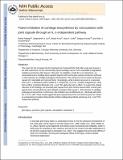Potent inhibition of cartilage biosynthesis by coincubation with joint capsule through an IL-1-independent pathway
Author(s)
Grodzinsky, Alan J.; Patwari, P.; Lin, S. N.; Kurz, Bodo; Cole, Ada A.; Kumar, S.; ... Show more Show less
DownloadGrodzinsky-2009-Potent inhibition of cartilage.pdf (1.915Mb)
OPEN_ACCESS_POLICY
Open Access Policy
Creative Commons Attribution-Noncommercial-Share Alike
Terms of use
Metadata
Show full item recordAbstract
The reason for the increased risk for development of osteoarthritis (OA) after acute joint trauma is not well understood, but the mechanically injured cartilage may be more susceptible to degradative mediators secreted by other tissues in the joint. To establish a model for such interactions, we coincubated bovine cartilage tissue explants together with normal joint capsule and found a profound (∼70%) reduction in cartilage proteoglycan biosynthesis. This reduction is due to release by the joint capsule of a heat-labile and non-toxic factor. Surprisingly, while cultured synovium is a canonical source of interleukin-1 (IL-1), blockade either by soluble IL-1 type II receptor (sIL-1r) or IL-1 receptor antagonist (IL-1RA) had no effect. Combined blockade of IL-1 and tumor necrosis factor α (TNF-α) also had no effect. To support the clinical relevance of the findings, we harvested joint capsule from post-mortem human knees. Human joint capsule from a normal adult knee also released a substance that caused an ∼40% decrease in cartilage proteoglycan biosynthesis. Furthermore, this inhibition was not affected by IL-1 blockade with either sIL-1r or IL-1RA. These results suggest that joint capsule tissue from a normal knee joint can release an uncharacterized cytokine that potently inhibits cartilage biosynthetic activity by an IL-1- and TNF-independent pathway.
Date issued
2009-08Department
Massachusetts Institute of Technology. Center for Biomedical Engineering; Massachusetts Institute of Technology. Department of Biological EngineeringJournal
Scandinavian Journal of Medicine & Science in Sports
Publisher
John Wiley & Sons, Inc.
Citation
Patwari, P. et al. “Potent inhibition of cartilage biosynthesis by coincubation with joint capsule through an IL-1-independent pathway.” Scandinavian Journal of Medicine & Science in Sports 19 (2009): 528-535. Web. 26 Oct. 2011. © John Wiley & Sons, Inc.
Version: Author's final manuscript
ISSN
1600-0838